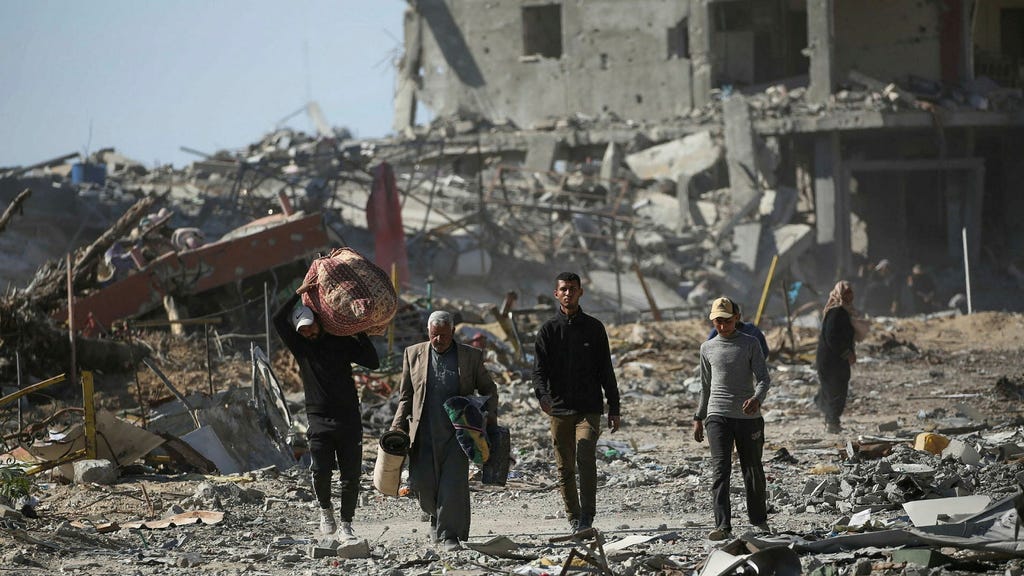The Aftermath of War: Gaza’s Devastated Landscape and a Fragile Truce
The fifteen-month war in Gaza has left an indelible scar on the Palestinian territory, with a confirmed death toll exceeding 47,000 according to Palestinian health authorities. The true extent of the devastation remains unknown, as thousands more are feared to be buried beneath the rubble of destroyed buildings. As a fragile ceasefire takes hold, the arduous task of recovering bodies and rebuilding shattered lives has begun. The scale of destruction is almost incomprehensible, with estimates suggesting that approximately 60% of all buildings in the Gaza Strip have been either damaged or completely destroyed. This level of devastation paints a grim picture of the immense challenges facing the Palestinian people in the aftermath of this protracted conflict.
The second day of the ceasefire has witnessed a wave of возвращений, as thousands of displaced Palestinians begin the tentative journey back to their homes. Amidst the scenes of devastation, search and rescue operations are underway, racing against time to locate those buried beneath the debris. Mahmoud Basal, a spokesperson for the Palestinian rescue services, estimates that around 10,000 Palestinians remain missing, lost amidst the wreckage. The search for survivors and the recovery of bodies will be a long and difficult process, further compounding the trauma experienced by the Palestinian population. The sheer number of missing individuals underscores the immense scale of the human tragedy unfolding in Gaza.
The ceasefire agreement, which came into effect on Sunday, offers a glimmer of hope amidst the despair. Beyond the cessation of hostilities, the agreement stipulates the daily passage of at least 600 trucks carrying vital humanitarian aid across the border into Gaza. This influx of aid is crucial for addressing the immediate needs of the affected population, providing essential supplies such as food, water, medical equipment, and shelter materials. According to UN Secretary-General Antonio Guterres, over 630 trucks successfully entered Gaza on Sunday, marking a positive first step in the delivery of much-needed assistance. This initial success provides a crucial lifeline to the people of Gaza, but the sustained flow of aid will be paramount in the long-term recovery process.
Hamas, the militant group that has controlled Gaza since 2007, has declared its intention to "rise again" and rebuild the shattered territory. The group’s statement reflects a spirit of resilience in the face of unimaginable destruction. However, the immense scale of the rebuilding effort will require substantial international support and cooperation. The reconstruction of homes, infrastructure, and essential services will be a long and arduous undertaking, requiring a sustained commitment from the international community. The ability of Hamas to effectively manage the reconstruction process and ensure the equitable distribution of aid will be critical to the recovery effort.
Within Israel, the decision to accept the ceasefire agreement was met with both support and strong opposition. The Israeli government voted 24-8 in favor of the truce, reflecting the complex political landscape surrounding the conflict. The acceptance of the ceasefire prompted the resignation of Itamar Ben-Gvir, Israel’s far-right police minister, who condemned the truce as a "victory for terrorism." Ben-Gvir’s departure highlights the deep divisions within Israeli society regarding the handling of the conflict and the terms of the ceasefire. He further urged Finance Minister Bezalel Smotrich to follow suit, a move that could potentially destabilize Netanyahu’s coalition government.
While Smotrich has not yet resigned, he threatened to do so unless the war resumes, reflecting the ongoing tensions within the Israeli government. In a Facebook post, Smotrich cited a "sense of duty" to the country as the reason for remaining in his position, claiming to have received assurances that the war would not conclude until Israel achieved its military objectives. This internal dissent within the Israeli government adds another layer of complexity to the already fragile ceasefire and raises concerns about the long-term stability of the agreement. The ongoing political maneuvering within Israel underscores the delicate balance between maintaining a fragile peace and addressing the deep-seated divisions within the country. The future of the ceasefire and the prospects for a lasting peace remain uncertain, with the potential for renewed conflict always looming large.














